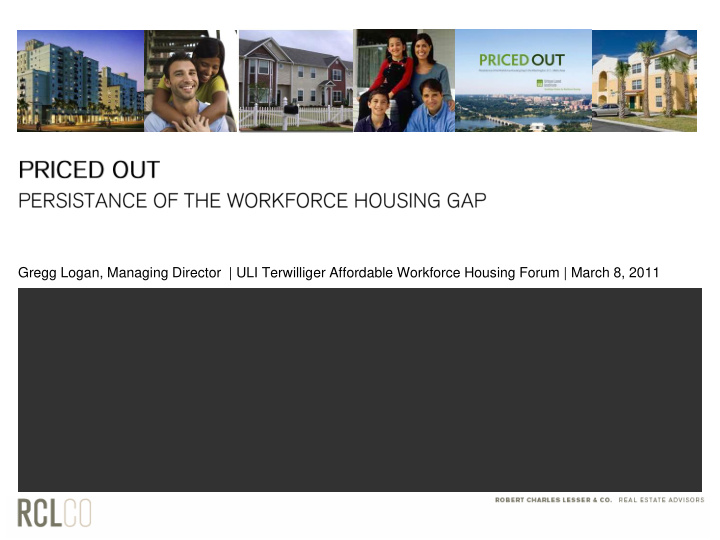



Gregg Logan, Managing Director | ULI Terwilliger Affordable Workforce Housing Forum | March 8, 2011
Sources: RCLCO; Census; Moody ’ s Economy.Com 1
• One in four working households have a severe housing cost burden • More than half of income spent on housing • About 10.5 million working households, an increase of nearly 600,000 households from the prior year • Affects working households at up to 120 percent of AMI • Most prevalent among the households with the lowest incomes • Key factors: • High unemployment • Falling incomes 2
Largest metros growing larger, faster, sprawling further Nation becoming majority minority…under -18, non-white population in large metros already majority Nation experiencing demographic dumbbell with boomers and seniors at one end and Gen Yers at the other extreme Household formation suspended by great recession, increasing pent up demand High unemployment and stagnating incomes creating growing divide between low- and middle-wage workers and high-wage workers 3
Regions composed of a hierarchy of Cores, or “ centers ” , job concentrations 30% to 40% of ALL jobs, including highest paying, locate primarily in these Cores o The number, quality, characteristics of Cores in a region influences job growth High correlation between where the best jobs are, and high housing costs
Darker red = higher average Single-Family Home Sales Price San Diego County, California Employment Cores Greater than $600,000 $450,000 to $600,000 $300,000 to $450,000 $150,000 to $300,000 Less than $150,000 High quality, high paying tech and office jobs are virtually all located near executive housing. SOURCE: SANDICOR 5
➧ PREFERENCES AND POLICIES Infill often more attractive to communities • More efficient use of transportation investments, infrastructure • Reduce driving, environmental impacts, sometimes less costly to provide services • Placemaking, walkability, as catalyst Greenfield less costly to the developer • Lower land costs • Fewer financing barriers • Less expensive infrastructure (e.g. less transit, open parking) • Responsive to consumer preferences for lower density More Infill will require more public/private partnerships • Help with infrastructure, co-investment, tax abatement, etc.
Key Findings Workforce households (representing 30% of the workforce in cities studied) are still Priced Out of employment rich locations in high cost U.S. cities Centripetal dispersion of workforce households is intensifying Long-term future deficit is quantifiable and untenable Families are particularly impacted Cost burden also applies to rental households Construction realities make building new workforce housing extremely challenging in employment and transit rich locations 7
Boston Washington Bay Area 8
Boston Washington Bay Area 9
Boston Washington Bay Area 10
11
New rental apartments in the Boston area, and other high-cost metro areas, too expensive to build 12
4,200,000 Largest group began graduating in 2009 – Greatest demand for rental housing in this 4,100,000 period 4,000,000 If this group rents for at least three years, 3,900,000 there will be more first-time homebuyers in the market in 2013-2018 than ever 3,800,000 before 3,700,000 3,600,000 3,500,000 3,400,000 2000 2001 2002 2003 2004 2005 2006 2007 2008 2009 2010 2011 2012 2013 2014 2015 2016 2017 2018 2019 2020 Number of 22 Year Olds Same 22 Year Olds Turn 25 NOTE: Number of 22-year olds is based upon birth rate and does not factor in death rates and migration. SOURCE: U.S. Centers for Disease Control and Prevention
• Driven by convenience, connectivity, and a healthy work-life balance to maintain relationships • 1/3 say they ’ d pay more to walk to shops, work, and entertainment (can they afford it?) • 2/3 say that living in a walkable community is important • More than 1/2 of Gen Y would trade lot size for proximity to shopping or to work • Even among families with children, 1/3 or more are willing to trade lot size and “ ideal ” homes for walkable, diverse communities SOURCE: RCLCO Consumer Research 14
’ • Growing income disparity • Avg. income in 1988 was $33,400 • Avg. income in 2008 was $33,000 • Incomes for wealthiest Americans ($383k+) grew 33% • Globalization, educational attainment gap, stock market gains are the culprets Source: IRS, CNN, Piketty and Saez 15
SENIOR HOUSING DELAY IN DEMAND FOR RETIREMENT HOUSING Baby Boomers Estimated Rate of Retirement 2008 to 2030 SOURCE: National Center for Health Services, NOTE: Based on an average retirement age of 62 according to the U.S. Census, Age 65 based on Metlife Middle Boomers Survey 16 16
Original cost - $54M Catalyzed Investment - $3.8B Multiplier – 74X SOURCE: RCLCO, Reconnecting America 17
The high cost of land, entitlement, and construction make developing new workforce housing near employment cores challenging. Without creative new ways to help finance housing for workforce households, job rich areas will face a further shortage of units, leaving workers vital to the regional economy PRICED OUT 18
Gregg Logan, Managing Director | ULI Terwilliger Affordable Workforce Housing Forum | March 8, 2011
Recommend
More recommend